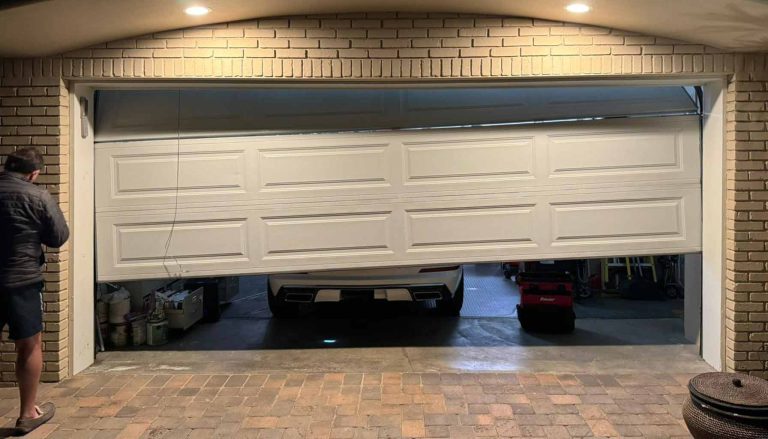A garage door is one of the most essential components of any home. It not only provides security but also adds convenience and curb appeal. However, like any mechanical system, garage doors experience wear and tear over time. One of the most common issues homeowners face is broken garage door springs.
When springs break, the garage door can become heavy, unsafe, and impossible to operate. Understanding how garage door springs work, why they break, and how to repair them can help homeowners make the right decisions when these problems arise. In this article, we will explore the causes, signs, and solutions for broken garage door springs.
Understanding Garage Door Springs
Garage door springs are designed to counterbalance the weight of the door, making it easy to open and close, either manually or with an automatic opener. Without springs, a garage door—often weighing 150 to 400 pounds—would be too heavy to lift safely.
There are two main types of garage door springs:
- Torsion Springs
- Mounted horizontally above the garage door.
- Use torque (rotational force) to lift the door.
- Known for durability and smoother operation.
- Extension Springs
- Installed vertically or horizontally on either side of the door.
- Stretch and contract to counterbalance the door’s weight.
- Generally less expensive but also less durable than torsion springs.
Both types serve the same purpose: ensuring safe, controlled movement of the garage door.
Why Do Garage Door Springs Break?
Garage door springs are under constant tension and pressure. Over time, they weaken and eventually snap. Common causes include:
- Normal Wear and Tear
Springs have a limited lifespan, measured in cycles (one cycle = opening and closing the door). Most standard springs last between 7,000 to 10,000 cycles, which equates to about 7–10 years of average use. - Rust and Corrosion
Moisture and lack of lubrication can cause springs to rust, weakening the metal until it breaks. - Lack of Maintenance
Springs require periodic lubrication and inspection. Without maintenance, they wear out more quickly. - Poor Installation or Low-Quality Springs
Using the wrong size or low-quality springs can shorten their lifespan and increase the risk of breakage. - Excessive Use
Households that use the garage door as the main entrance may wear out springs much faster.
Signs of Broken Garage Door Springs
Recognizing the signs of a failing or broken spring is important for safety and timely repair. Common symptoms include:
- Door won’t open or close properly – The door may get stuck or feel extremely heavy.
- Loud bang from the garage – When a spring breaks, it often makes a sharp, loud noise.
- Cables appear loose or hanging – Though cables themselves may not be broken, they lose tension when springs fail.
- Crooked or uneven door – The door may rise unevenly or tilt to one side.
- Gaps in the spring – If you can see a visible break or gap in the coil, the spring has snapped.
- Automatic opener struggles – The opener may hum, strain, or fail to lift the door because the springs are no longer supporting the weight.
Why Broken Garage Door Springs Are Dangerous
Attempting to operate or repair a garage door with broken springs can be very dangerous. Springs are tightly wound and under extreme tension. A sudden release of energy can cause serious injuries or damage to property.
Dangers include:
- The garage door slamming shut unexpectedly.
- The door opener motor burning out from excess strain.
- Personal injury while attempting a DIY repair.
For safety reasons, spring replacement should always be performed by a trained garage door technician.
Professional Garage Door Spring Repair
When springs break, the best solution is to call a professional repair service. Here’s what you can expect during the repair process:
- Inspection and Diagnosis
A technician will examine the door, springs, cables, and opener to confirm the problem and check for additional issues. - Safe Removal of Broken Springs
Using specialized tools, the technician carefully unwinds and removes the damaged springs. - Installation of New Springs
New torsion or extension springs are installed, matched precisely to the weight and size of the garage door. - Balancing and Adjustment
The technician ensures the springs are balanced so the door moves smoothly and evenly. - Testing the Door
The repaired system is tested multiple times to confirm safe operation. - Lubrication and Maintenance Tips
Proper lubrication is applied to extend the lifespan of the new springs, and homeowners receive advice on upkeep.
DIY vs. Professional Repair
While some homeowners may consider replacing springs themselves, it’s important to understand the risks.
- DIY Risks:
- High risk of injury due to tension in the springs.
- Potential for damaging the garage door system.
- Incorrect installation can lead to further breakdowns.
- Professional Benefits:
- Safe, efficient, and correct installation.
- Access to high-quality springs and parts.
- Warranties and guaranteed service.
- Peace of mind knowing the repair was done right.
For these reasons, DIY spring replacement is not recommended.
Preventing Future Spring Problems
While springs will eventually wear out, proper care can extend their lifespan. Here are some preventive maintenance tips:
- Regular Lubrication
Apply garage door lubricant to springs every 3–4 months to reduce friction and prevent rust. - Routine Inspections
Check for signs of wear, rust, or imbalance. Early detection prevents unexpected breakdowns. - Limit Excessive Use
If possible, use other entrances to reduce daily cycles. - Balance Testing
Have a technician test the door balance annually. A properly balanced door reduces strain on springs and the opener. - Upgrade to High-Cycle Springs
Consider installing springs rated for 20,000 or more cycles for longer durability, especially in busy households.
Cost of Garage Door Spring Repair
The cost of spring repair varies depending on the type of springs, door size, and labor rates. On average:
- Standard torsion spring replacement: $150–$300 (including parts and labor).
- Extension spring replacement: $100–$200.
- High-cycle spring upgrades: Additional cost but longer-lasting.
While repair costs may seem high, replacing springs ensures safety and prevents expensive damage to the garage door opener or other parts.
Conclusion
Broken garage door springs are one of the most common and frustrating problems homeowners face. When springs fail, the garage door becomes heavy, unsafe, and inoperable. While it may be tempting to attempt a DIY fix, the risks outweigh the benefits. Professional repair services provide safe, reliable, and long-lasting solutions.
By understanding how springs work, recognizing the warning signs of failure, and investing in regular maintenance, homeowners can extend the life of their garage door system. And when replacement is needed, a professional technician ensures that your garage door operates smoothly, safely, and efficiently for years to come.








